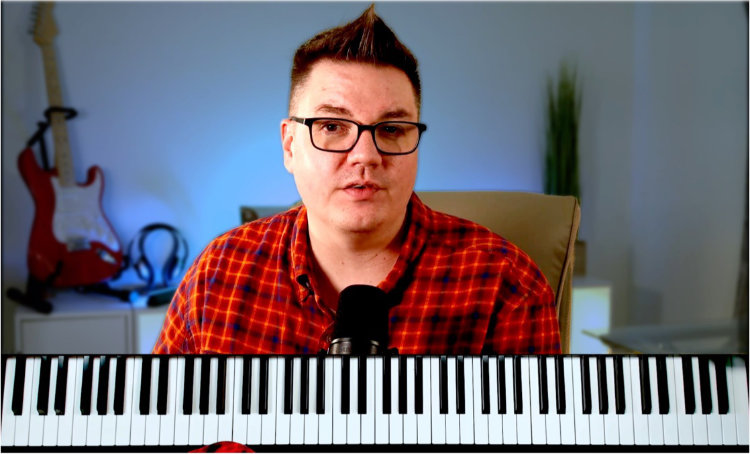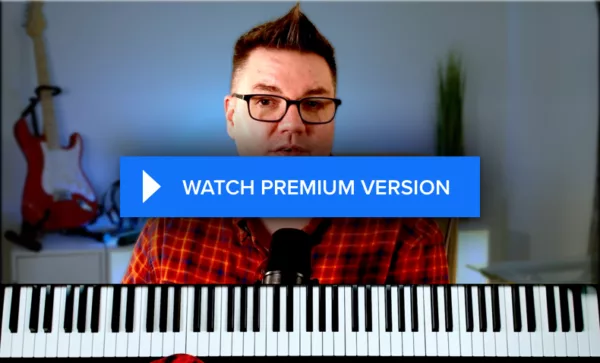A "sharp-11" chord can be little intimidating of a concept, especially if you are new to playing jazz, but it's actually one of the most common ways to color major and dominant chords. In this article, we’ll explore various ways to use this chord in your playing.
What is a Sharp-11 chord? A sharp-11 chord, also called a Lydian chord, is a major or dominant 7th chord that includes a raised 11th (4th) scale degree.
How to find the Sharp-11 #
Finding the 11th scale degree is quite simple. You start at the root of the chord and count up 11 notes using the major scale. For example, in the key of C, F is our 11.

Now, to find the sharp-11, we simply raise our 11 by a half step. In this example, our F becomes and F#.


Step-by-Step Video Training
As a premium member of Jazz-Library you will have access to our Jazz Fundamentals video course which has 70+ video lessons teaching you all about these chord extensions and alterations, and much more.
At this point my students often ask me why we can’t simplify this further and just think about this as a Sharp-4 instead? The reason is because, by convention, any chord with a number larger than 7 implies that it’s an extension of a 7th chord, but anything smaller than 7 only extends the base triad. As such, a C11 chord would be a C7 chord, with an 11 added, but a C(add4) would be a C triad with a 4th added, but not a 7.
That said, thinking of the 11 as the 4 is a helpful shortcut to find the note quickly while learning these voicings.
The dominant 7 sharp-11 chord #
Without a doubt, the most common use of the sharp-11 is for coloring dominant 7th chords. Within a cadence, the sharp-11 of the V chord creates a strong half-step resolution to the root of the I chord as illustrated below in both major and minor keys:

The major 7 sharp-11 chord #
The major 7 sharp-11 chord, also known as the Lydian Chord, can be used to create a floating, pleasing and only slightly unresolved major chord sound.
The only real "gotcha" with this is to avoid using it when the melody note is on the 5th, as the sharp-11 is only a half-step away and causes unpleasant dissonance.
It really shines when the melody note is the 3rd, 7th or 9th of the chord.
The minor 7 sharp-11 chord #
We don't actually see this chord very often. In fact, I can't think of a time I've ever seen it. Jazz is all about creative expression and breaking rules, so I'm sure someone has used it prominently, but I'm at a loss...
Perhaps this is because of just how similar a minor 7 sharp-11 chord is to the minor 7 flat-5, also known as the half-diminished. The sharp-11 and flat-5 are enharmonically the same note -- more on the later.
Sharp-11 chords found in lead sheets #
When playing from lead sheets, a sharp-11 chord is usually something left up to your creative discretion. Even when it’s not notated explicitly, any major or dominant chord can be altered with a sharp-11 if it is attractive to you.
For that reason, you actually don’t see sharp-11 chords notated in lead sheets very often. But, when they do show up, it’s usually because the melody contains that note.
Consider the first line of Take the "A" Train, which has a G# as the sharp-11 of the D7 chord:

Or, take this other example from The Girl from Ipanema, which does this twice in a row, first with the G# as the sharp-11 of D7, and then again as the F# on a C7 chord.

Occasionally you will find a sharp-11 written when it's not the melody note, perhaps as a node to a classic recording which used that voicing.
Sharp-11 evokes lydian mode #
The sharp-11 is commonly used as an alteration -- a note which doesn't belong to the current scale -- as a way to add unique chord colors. That said, the chord is a close cousin of the Lydian Mode as the sharp-11 is the same note as the Lydian's raised 4th degree.
Because of this, it works particularly well when playing a major chord on the 4th scale degree, like on the Fmaj chord in the key of C.
Using sharp-11 chords as tritone substitutions #
The sharp-11 chord is also a really great choice for dominant chords which function as tritone substitutions. This is because the sharp-11 is a tritone away, and so the sharp-11 in the substituted chord is the root of the original chord.
Look at the last chord from this example, excerpted from the B section of George Shearing's classic, Lullaby of Birdland:

How to voice the sharp-11 chord #
Here are some conventional ways of voicing a dominant chord with the sharp-11:
This one is a bit more unconventional, but one that I'm particularly fond of. It's similar to a quartal voicing, and sounds a little bit diminished with the sharp-11 on the bottom and the root in the middle:
Any of the dominant chord voicings also work really well for major chords if you raise the flat-7 back up to a natural 7. Here are a couple other common ones I use.
The major 2nd upper structure triad #
It can be intimidating to learn your sharp-11 voicings in all the keys. But don't worry, there's a little trick you can use to voice a sharp-11 chord every time!
- Play the chord shell in your left hand.
- Play a triad a major 2nd above the root in your right hand.
Simply put, we're stacking a triad a whole step up on top of the base chord. In the key of C, you would play a C chord in your left hand and a Dtriad in your right hand.
To take this a little further, play with different inversions of that upper-structure triad to find the voicing that best fits your situation:
Note: I've illustrated these using dominant chords, but the same technique applies for major chords as well.
Combining sharp-11 with other altered extensions #
With dominant chord voicings, feel free to experiment with combining the sharp-11 with other altered chord extensions like flat-9, sharp-9, and flat-13.
Typically the sharp-11 "stands alone" as the overtones produced when combining with other alterations can get a bit muddy. That said, they don't really clash in any harmful way, it just loses a bit of its crispness.
C7 (#9,#11)
C7 (#11, b13)
The difference between sharp-11 and flat-5 #
In the key of C, the sharp-11 is F# and the flat-5 is Gb. Those are enharmonically the same note. So, is "sharp-11" just a different way of writing a "flat-5" chord?
Technically speaking, they are not the same chord. But practically speaking, the differences are very subtle. Theory snobs (guilty as charged) will explain that the sharp-11 chord contains both the five and the sharp-11, where the flat-5 chord replaces the 5 with the flat-5.
Both function as dominant chords, creating a pull back to the tonic. The flat-5 chord may have a slightly stronger pull, given the 3, b5, and b7 notes create a diminished triad which is ever so slightly less stable than the sharp-11 chord.
Look, we're splitting hairs here a bit. In practice, they are used interchangeably all the time.
Scales to use when soloing over sharp-11 #
When soloing over a dominant sharp-11 chord, you have a number of choices to pick from:
- Blues Scale:
C, Eb, F, F#, G, Bb - Half-Whole Diminished Scale:
C, Db, D#, E, F#, G, A, Bb - Altered Scale:
C, Db, D#, E, F#, Ab, Bb - Lydian Dominant Scale:
C, D, E, F#, G, A, Bb
For major chords, the Lydian scale is really the most common choice: C, D, E, F#, G, A, B.
